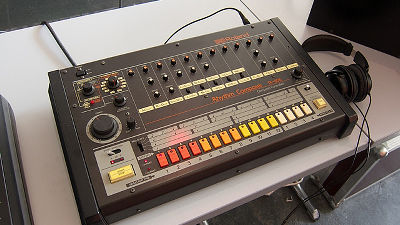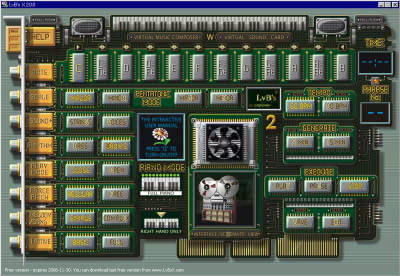The secret of the birth of the sound "everyone knows" with the ornate sound of "Jean!" "Orchestra hit"

ByJiuguang Wang
The sound of "Orchestra Hit" such as Michael Jackson's "BAD" at the beginning and the intro part of Jesus' "Lonely Heart" has been used impressively in many songs, so that hearing music even a little If you are a person, you should definitely have heard it once. The sound of the orchestral hit which was built also in the low price synthesizer which cuts below 10,000 yen has appeared in the 1980's, and shocked people with the introduction of certain electronic musical instruments.
The sound that connects Stravinsky to Bruno Mars - YouTube
An orchestral hit is a literal sound that an orchestra took out a piece playing a classical song. Its origins are Russian composersIgor StravinskyAnnounced in 1910Fire birdis.

The starting part of the original novel "Orchestra Hit" is used as a part of the beginning of the "evil dance of the Demon Lord Kastei" which is a composition of suite "Fire bird". It is the part where the orchestra plays very powerfully in the tutti (whole) with the sound of "Fortissimo" with three fortifications followed by Forte.

So how can one phrase of classical classical songs be incorporated into a wide range of music such as hip hop and pop? The key to that mystery is in Australia.

The orchestral hit was made known to the world by the synthesizer which Fairlight Company of Australia released in 1980Fairlight CMI"was.

Fairlight CMI is a machine announced around the time digital technology began making music, and it is possible to perform three roles of "digital synthesizer", "digital audio workstation" and "digital sampler" Possible. Alongside "Sinklavia" developed by New England Digital Inc., it is known as the state-of-the-art aircraft and it can be said to be the origin of modern DTM (desk top music).

Fairlight CMI has the feature of "Computer screen and performance contents are consistent" which can be said commonly in the modern era, and it was decided to change the way of music production greatly.

Moreover, by installing a digital sampler, it became possible to reuse so-called "raw sound" as one of synthesizers' sounds.

With Fairlight CMI, it was possible to write a note to the desired position by hitting the light pen on the monitor screen. In the past, music production of "driving" which was typing numerical values using the numeric keypad can now be performed by intuitive operation.

This was a simple sequencer function called "Page R". Herbie Hancock, who had acquired Fairlight CMI at the time, has left a picture explaining how to use the music producer Quincy Jones.

This operation, which directly touches the screen of the CRT monitor later ......

This leads to an operation of touching the screen of the iPhone with the finger and typing the note.

This interface revolution was backed by many musicians. Stevie Wonder is one of the musicians who got Fairlight CMI the first time ... ...

British Peter Gabriel (Gabriel) is one of them.

Also, Kate Bush in the UK and ...

Led Zeppelin and others also got Fairlight CMI one after another. By the way, the price of Fairlight CMI at that time was 12 million yen, converted to the value of 2018 about 15.5 million. Although it was cheaper than Sink Lavier, which was said to be about 100 million yen, it was a price quotation as an instrument.

However, the biggest function that changed the music afterward can be said to be a digital sampler.

Although we could connect the microphone to the Fairlight CMI main unit and record it and reuse it, it became a paradigm shift in music production that it is possible to exchange sampling data as digital data via an 8-inch floppy disk It was.

In modern times you can exchange data instantaneously over the net. But in the 1980s mailing a floppy disk containing data to it, it is precisely to let the acquaintance to say, "This is the sound I made." Nonetheless, this environment has made people see the future of music production witnessed.

Digital samplers will also be widely used for actual music production. Peter Gabriel sampled the sound that breaks the glass of a cathode ray tube TV discarded in a waste storage place ......

I use it as part of Kate Bush's song "Babushuka". You can hear the actual sound in 2 minutes 21 seconds of the following movie.
Kate Bush - Babooshka - Official Music Video - YouTube
It was the sound of an orchestral hit that was offered as one of the materials of such a digital sampler. According to Peter Vogel, one of the inventors who invented Fairlight CMI, the orchestral hit sound was born accidentally. By chance you own a record of Stravinsky's "Fire Bird" ... ...

It seems that we chose to capture as "sample sound" from the beginning that "Jean!" Sounded cool.

Mr. Vogel gave this file a file name of "ORCH 2. VC", and recorded it on an 8-inch floppy disk as one of many other materials and made it public.

Then, many musicians turned their eyes to "ORCH 2. VC" and started to use them in the music. The first thing that became famous is the impressive feature of the hip-hop founder Africa Bambata's song "Planet Rock", part of the beginning and part of the rust.
Afrika Bambaataa - Planet Rock - YouTube
After that, "Orchestra Hit" became one of the classic sound sources of a number of synthesizers, and it became a tone that is always recorded in each one. In addition, the manner in which it is used in songs has also become sophisticated, and it has come to be more timely to incorporate the sounds and arrangements that have been integrated into the song more naturally from sound use with a sense of roundness such as "anything orchestral hits" It was.

Speaking of "orchestral hits", however, it also creates a sense of retro somewhere that makes the 80s dafty. It is Bruno · Mars which is taking advantage of such atmosphere well, adopting Retro feeling well in the style, I am using the tone that makes you feel "ORCH 2. VC" in the songs daringly.
Bruno Mars - Finesse (Remix) [Feat. Cardi B] [Official Video] - YouTube
The "orchestral hit" which was exactly the outskirts of the world came to be loved by people born from one high-performance digital synthesizer. At the end of the movie, Mr. Vogel shows me the record of Stravinsky 'Fire Bird' used for actual sampling ... ...

There was a price tag of 6.99 Australian dollar (about 600 yen) stuck there. From the record you got second hand, the shocking sound that changed the world after that was born in this way.

Related Posts:







